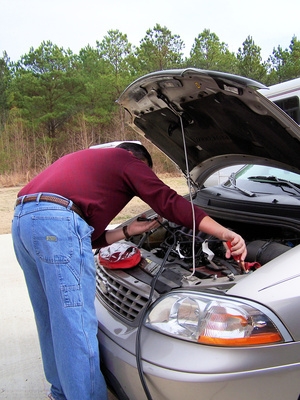
Battery terminals are used to attach leads to the battery. A wide variety of battery terminal types exis. Automotive batteries and alkaline batteries (the small batteries that power flashlights) are the most commonly used batteries, and the types of terminals used by each varies mostly by where they are located.
The most common terminal type for an automotive battery is the top post. Two round, metal projections on the top of the battery are designed to hold a cable clamp. The negative terminal is often a little smaller than the positive terminal to distinguish between them; the negative terminal is usually labeled with a minus sign or a black plastic cover; positive terminals are labeled with the plus sign and red tabs. Top post terminals come in two sizes: standard post terminals, where the positive terminal is 20 mm and the negative terminal is 16 mm; and pencil post terminals, which have a 15 mm positive terminal and a 13 mm negative terminal.
The side post type of battery as the name implies, has the posts on the side of an automotive battery, typically on the edge of the battery near the top. The side post type of terminal does not have a projection; instead it consists of a threaded socket where a bolt on battery clamps is inserted. If a bolt is reinserted or replaced, over-tightening is a danger. Using a torque wrench set to 6 to 8 foot-pounds avoids any problem.
Some lead-acid batteries come equipped with two types of battery terminals. Called dual terminal or dual post, this design has two distinct variations. One variation consists of both top post terminals and side post terminals. The other consists of top post terminals that are tapped so that a bolt-clamp can be inserted. A dual post or dual terminal design provides a choice in connecting the battery to the battery cables.
Most household batteries have "flashlight" style terminals on either end of the cylinder. A small metal cap projects out of the top of the battery and is the positive terminal, while a flat metal base serves as the negative terminal. These terminals will connect with either springs or metal strips in the battery holder.
Some household batteries have both terminals on the top. Typical 9 volt alkaline batteries, which are used in smoke detectors and digital clocks, have snap terminals. The negative terminal has a hexagon shape, while the positive terminal is circular. Each of these terminals fits or "snaps" into a power connector that also has the exact same type of terminals, with each positive terminal snapping into the opposing negative terminal.
6-volt lantern batteries have springs for terminals, than can be attached with screw-type connectors or simple metal contacts.